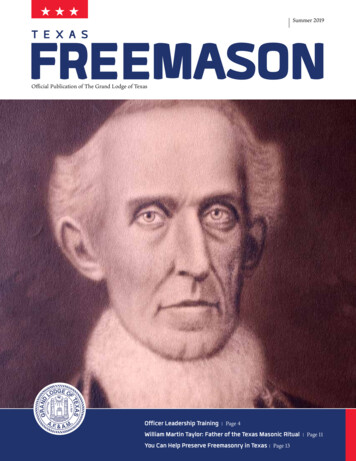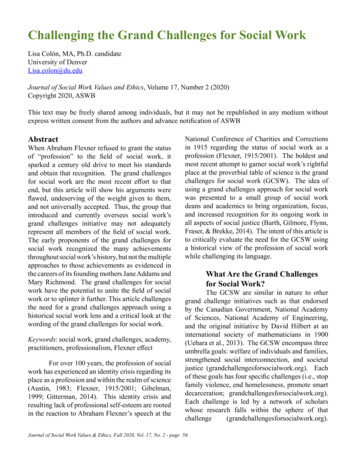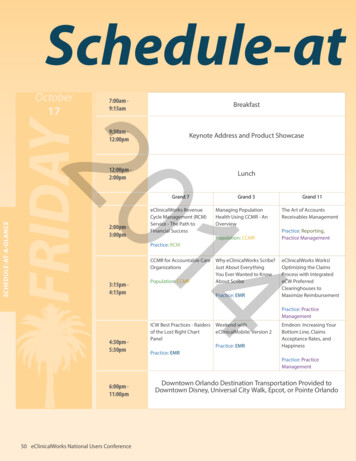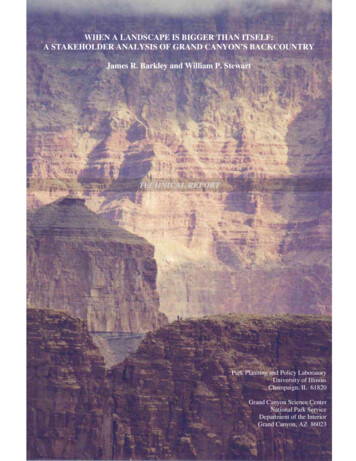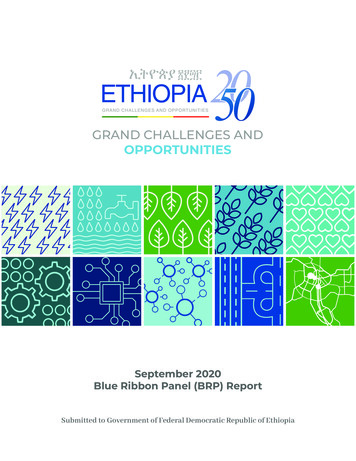
Transcription
GRAND CHALLENGES ANDOPPORTUNITIESSeptember 2020Blue Ribbon Panel (BRP) ReportSubmitted to Government of Federal Democratic Republic of Ethiopia
“Never doubt thata small group ofthoughtful, committedcitizens can changethe world, indeed itis the only thing thatever has.”Margret Mead2www.ethiopia2050.com
BlueRibbonPanelReportBlueRibbonPanelReportETHIOPIA 2050TABLE OF CONTENTSExecutive Summary10I. Introduction13Background13Objective17Scope and Structure of Report19II. Grand Challenges and Overarching Themes20A. Urbanization22B. Water-Food-Health-Energy (WFHE) Nexus32C. Sustainable Economic Growth and Job Creation Drivers43C1 Rural Development44C2 Digital Economy49C3 Building World-Class Workforce Training56C4 Transportation Infrastructure63C5 Construction Industry68C6 Advanced Manufacturing71C7 Sustainability and Environment Security74D. Institution Building76E. Girls’ Education and Empowering Women79F. Funding and Good Governance84III. Multi-Generational Execution Plan85IV. Conclusions93References97AppendixAnnex I – Ten Grand Challenges106Annex II – Proposed Funding Mechanisms107Annex III – List of Authors and Idea Generators108Annex IV – List of the ETHIOPIA 2050 Community111www.ethiopia2050.com3
ETHIOPIA 2050INTERNATIONAL STEERING COMMITTEEEngineer Tesfaye Workineh (Co-Chair), Former President, Ethiopian Association of CivilEngineers.Professor Shifferaw Taye (Co-Chair), Professor, Addis Ababa University & Min. ofConstruction.Professor Samuel Kinde (Co-Chair), Professor, San Diego State University, California, USA.Engineer Abdissa Lemma, President, Ethiopian Society of Mechanical Engineers.Engineer Amare Mergia, Ethiopian Society of Electrical Engineers.Professor Asrat Worku, Professor, Addis Ababa University.Engineer Dejene Woldemariam, ACME Engineering and Davis & Shirtliff, EthiopiaDr. Demrew Getachew, Head of Secretariat of Ethiopian Economic Association.Engineer Deres Tesfaye, ICT Consultant, USA.Professor Desta Mebratu, Extraordinary Professor at CST, Stellenbosch University, SouthAfrica.Engineer Eyob Berhane, Yeshi-Ber Consult PLC.Ato Gabriel Seifu, Senior Analyst, Government of Canada.Engineer Hailu Seifu, Managing Director, ACME Engineering.Dr. Ing. Hundessa Deslalegn Demsash, President, Ethiopian Society of Chemical Engineers.Architect Mahder Tadesse, Secretary, Association of Ethiopian Architects.Professor Masresha Fetene, Former Executive Director, Ethiopian Academy of Sciences.Architect Rodas Seyoum, Association of Ethiopian Architects.Engineer Samrawit Kassaye, President, Ethiopian Society of Electrical Engineers.Engineer Seifu Bihonegn, Ethiopian Association of Civil Engineers.Engineer Shiferaw Alemu, Ethiopian Association of Civil Engineers.Dr. Tesfaye Teshome, Associate Professor, Unity University.Architect Yasmin Abdu Bushra, Association of Ethiopian Architects.Engineer Yohannes Afework, MEng, PMP: Management Consultant, Canada.ADVISORY BOARD MEMBERSDr. Arega Yirdaw, President, Unity UniversityDr. Tewolde GebreMariam, Group CEO of Ethiopian AirlinesAto Zafu Eyesuswork Zafu, Board Chair, United Bank SC; Vice Chair, Raya Brewery SC; Tech &Relations Advisor to CEO, United Insurance SC.DESIGN & DATA TEAMArchitect Mahder Tadesse, Association of Ethiopian ArchitectsArchitect Yasmin Abdu Bushra, Association of Ethiopian ArchitectsAto David Mesfin, INNOCEAN WORLDWIDE, California, USAAto Jomo Tariku, Designer/Data Scientist, Virginia, USA4www.ethiopia2050.com
Blue Ribbon Panel ReportACKNOWLEDGEMENTThe Blue Ribbon Panel would like to sincerely thank the ETHIOPIA 2050 Conference co-host organizations, JEEPA (JointEthiopian Engineering Professionals’Association), Ethiopian Science Academy(EAS), Ethiopian Economic Association(EEA), and Unity University for their unwavering support and dedication in making the ETHIOPIA 2050 Conference a reality. Our institutional partner, Association ofEthiopian Architects (AEA) and our mediapartner Capital Ethiopia Newspaper deserve our sincere thanks. We also wouldlike to thank the Ministry of Finance ofthe Government of Federal DemocraticRepublic of Ethiopia and Unity Universityfor the generous financial and materialsupport for hosting the ETHIOPIA 2050Conference at Skylight Hotel in AddisAbaba in December 2019.A special thanks to our Advisory Boardmembers, Dr. Tewolde GebreMariam(Group CEO of Ethiopian Airlines), Ato ZafuEyesuswork Zafu (Tech & Relations Advisor to CEO – United Insurance SC, BoardChair, United Bank SC, Vice Chair, RayaBrewery SC), and Dr. Arega Yirdaw (President, Unity University) for their advisoryroles and believing in the mission of thisInitiative.For the hundreds of hours of effortthat they volunteered over a period ofseveral months to produce this report, wealso would like to extend our sincere andspecial thanks to each and every memberof the Blue Ribbon Panel. We are indebted to Professor Prabhjot Singh, Dr. HailuMekonnen, and Dr. Aynalem Adugnawho spent several hours in editing andhelping shape this document to its finalstage. The Technical Advisory Groups whofine-tuned the ideas and recommendations and offered numerous suggestionsdeserve special recognition along withthe Design Team that put a professionaltouch to this report. Last but not least,our thanks go to the authors and sessionmoderators of the December 2019 Ethiopia 2050 Conference who covered theirown expenses and travelled to Addis toshare their vision for an Ethiopia of tomorrow. We can never repay that.www.ethiopia2050.com5
ETHIOPIA 2050BLUE RIBBONPANEL MEMBERS6www.ethiopia2050.com
Blue Ribbon Panel MembersBlue Ribbon Panel ReportDR. DEBREWORK ZEWDIE (Chair)Is Distinguished Scholar & Visiting Professor at City University of New York (CUNY),School of Public Health and Health Policy and Former Director of the World BankGlobal HIV/AIDS Program and Deputy Executive Director and COO of the GlobalFund. She had led research, strategy, policy implementation, and managementof development programs at country, regional, and global levels for the WorldBank and The Global Fund to Fight AIDS, Tuberculosis and Malaria. Dr. Debrework conceptualized and managed the first billion dollar multi-country HIV/AIDSProgram for Africa that changed the AIDS funding landscape and pioneered thelarge-scale multi-sectorial response with direct financing to civil society and theprivate sector. Dr. Debrework was trained as a clinical Immunologist at St. Mary’sHospital Medical School in London and worked on the HIV/AIDS epidemic for thelast thirty-five years. Dr. Debrework was a Senior MacArthur Fellow and a SeniorLeadership Fellow at Harvard University and has received honorary doctorate degrees from Ben-Gurion University of the Negev, Israel and the ICHAN School ofPublic Health at Mount Sinai, New York. Dr. Debrework had also served as DeputyDirector and later Acting Director of the National Research Institute of Health ofEthiopia and as Program Manager of Ethiopia’s AIDS/STD Prevention and ControlProgram. She is also a Fellow of the Ethiopian Academy of Sciences.PROFESSOR SAMUEL KINDE (Secretary)Is Professor of Mechanical Engineering at San Diego State University in Californiaand deputy director of US National Science Foundation funded Engineering Research Center called CNT (Center for NeuroTechnology). Professor Samuel holdsa PhD degree in Engineering Mechanics from Virginia Tech in the US and haspublished in various disciplines of engineering. He has founded several technology companies, the recent being Grapheton Inc, a company specializing in making carbon-based Brain Computer Interface (BCI) probes and supercapacitors forwearable and implantable devices.PROFESSOR ALEMAYEHU TEFERRAIs Fellow of Ethiopian Academy of Sciences and Professor of Civil Engineering atAAU. He obtained a master’s degree in civil engineering from Technion - IsraelInstitute of Technology and a PhD from Technical University of Aechen in Germany. He has served as the first elected President of Addis Ababa University (AAU)and Vice Chairperson of the Executive Board of UNESCO. Professor Alemayehuwas a senior Fulbright scholar at UC Berkeley in California, USA, and a recipient ofsilver medal from UNESCO and a plaque from the American Association for theAdvancement of Science (AAAS).www.ethiopia2050.com7
PROFESSOR ASSEFA HAILEMARIAMIs a fellow of the Ethiopian Academy of Sciences (EAS). He earned PhD in Population Studies from the London School of Economics and Political Science. He wasthe founder of the Demographic Training and Research Center (DTRC) at AddisAbaba University where he served as its Director for several years. Professor Assefawas instrumental in the drafting of the 1993 National Population Policy of Ethiopiaand the 2003 Youth Policy of Ethiopia. He is recipient of the National PlanningCommission of Ethiopia award (2014) and the Rockefeller Foundation ResearchAward, William Hewlett Fellowship and UN and FAO Fellowships. Professor Assefahas several publications on population-related subjects.PROFESSOR AYENEW EJIGOUIs Fellow of Ethiopian Academy of Sciences (EAS) and founding member and firstPresident of the Ethiopian Statistical Association. He had served Addis Ababa University (AAU) as Head of the Department of Statistics, Professor of Statistics, Chairman of the Advisory Board of the Institute of Development Research and as Member of the Senate. He has also served as Dean of the Faculty of Social Sciences atthe University of Lesotho.ATO TEFERRA MENGESHAIs a Transportation Planning/Transportation Economist and the Managing Directorof W.T Consult PLC in Addis Ababa. Ato Teferra holds a B.A Degree in Economicsfrom Haile Selassie I University (1971) and MSc Degree in Transportation Planningand Engineering from UNB-Canada (1987). A considerable part of his experience hasbeen acquired through specialized expertise in the preparation of road and airportprojects, and in the monitoring and evaluation of transport and other infrastructureprograms and projects, not only in Ethiopia, but also in Kenya, Rwanda, South Sudan,Liberia and Djibouti. In addition, he had been involved in urban transport planningand institutional design policy formulation and drafting strategies. During this period, Ato Teferra provided consulting services for the World Bank, the European Commission, the African Development Bank, U.K Aid, Irish Aid, KFW, JICA and ReCAP.PROFESSOR MENTEWAB AYALEWIs Vice Chair of Biology and Associate Professor at Spelman College in Atlanta,Georgia, USA. She obtained her Ph.D. in plant cellular and molecular biology atthe Ecole Nationale Superieure d’Agronomie de Toulouse, France. At Spelman, shehas put considerable emphasis on the integration of research, teaching, and student development. Professor Mentewab is also the co-director of the Living andLearning Community of STEM Scholars, a program initiated to foster intellectualengagement and provide mentoring and development opportunities to Spelmanstudents aspiring to pursue a STEM Ph.D. or an M.D. /Ph.D.8www.ethiopia2050.comBlue Ribbon Panel MembersETHIOPIA 2050
Blue Ribbon Panel MembersBlue Ribbon Panel ReportPROFESSOR SHIFFERAW TAYE(MBA, PPSt & Br, PPCoTeM) is an Associate Professor of Engineering Mechanics& Structural Engineering at Addis Ababa University and Advisor at the Ministryof Urban Development & Construction on Capacity Building. Professor Shifferawearned a PhD from Technion - Israel Institute of Technology and is a Fellow ofthe Ethiopian Academy of Sciences and Ethiopian Association of Civil Engineers(EACE) as well as a member of the American Society of Civil Engineers (ASCE),American Institute of Steel Construction (AISC), and International Association forBridges & Structural Engineering (IABSE).PROFESSOR TESHOME ABEBEIs Professor Laureate & Professor of Economics at Eastern Illinois University inCharleston, Illinois, USA. Prior to his current position, he served as DepartmentChair, Dean, and later as Associate Vice President at Colorado State University; Provost and Vice President for Academic Affairs at Ferris State University in Michigan;and Provost and Vice President for Academic Affairs at Eastern Illinois University. Dr.Teshome has co-authored three books and is a prolific essayist on Ethiopian affairs.ATO YILKAL ABATEIs Vice President of ICTET, an association of private sector ICT companies, andCountry Manager at Afmobi. He earned MBA from MIT and has over 20 years ofexperience in the development of IT solutions, risk management tools, softwareapps, and web technologies in the financial, education and consulting industries.He has previously worked at Liberty Mutual in Boston, AIG in NY, and Analysis International Ltd. UK. He was also the Founding Curator of the Addis Hub for GlobalShapers, a World Economic Forum (WEF) initiative.DR. Ing. ZEGEYE CHERENETIs Assistant Professor of Architecture and Design and Deputy Director of Ethiopian Institute of Architecture, Building Construction and City Development (EiABC)and has published extensively on urbanization issues in Ethiopia. He holds a PhDsumma cum laude on designing informal-searching strategies for waste-sensitive urbanization from HafenCity University (HCU) in Hamburg, Germany. He hasgiven guest lecturers at various universities in Ethiopia and abroad including as avisiting academic in the Department of Architecture at the Swiss Federal Instituteof Technology (ETH Zurich). Dr. Zegeye had also served as Chair of Architecture &Design at EiABC and General Secretary of the Association of Ethiopian Architects(AEA). Dr. Zegeye is a practicing architect and runs OADUS Architecture & Engineering with his partners based in Addis Ababa.www.ethiopia2050.com9
EXECUTIVE SUMMARYEthiopia is in the midst of a remarkableand unprecedented demographictransformation. By 2050, its population isprojected to double from 100 million to200 million people. This powerful demographic transition will also be accompanied by several other transformativenatural forces. These forces include pressure from ongoing societal, economical,geo-political, and environmental changesand disruptions. Arguably, the next setof potential conflicts in our region couldbe driven by the competition for valuable resources such as water and arableland that will be further exacerbated bypressure from population increase andadverse effects of climate change. Takentogether, the next thirty years will reshapeEthiopia’s identity, character, and its global role, as it navigates both unprecedented challenges and opportunities. Therefore, we must face the full impact of theseemerging forces head-on.To proactively address what were identified as “Ten Grand Challenges and Opportunities” associated with this expectedgenerational and historical demographicshift, an Initiative was launched to carefully examine, both the opportunities ofdemographic dividend and the associatedrisks. The approach in this Initiative wasguided by the consideration of populationas a central issue for both the challenges10www.ethiopia2050.comand opportunities side, because it is people who are the ultimate beneficiaries ofdevelopment.This report that comes out of this Initiative was prepared by a Blue Ribbon Panel(BRP) consisting of an independent groupof Ethiopian and Ethiopian-origin expertswith diverse professional backgrounds.They bring deep expertise across fields asvaried as economics, public health, statistics, education, population dynamics,technology, and urban planning. Together,they have formulated a transformativevision to proactively aid Ethiopia on itsjourney to a better future.The BRP rests upon a collective visionthat is part of the broader ETHIOPIA 2050Initiative and focuses on the actions thatpolicymakers can take, with broad support of the public. Their insights weregenerated after extensive and carefulvetting of the transformative new ideaspresented at an international conferenceheld on December 19th and 20th, 2019 inAddis Ababa which included 450 Ethiopian/Ethiopian origin participants from10 countries. This report presents a seriesof bold, feasible, and actionable ideas with an execution plan - that will havemulti-generational impacts.This report lays out a straightforwardand powerful rationale for actions in thefollowing areas:
Blue Ribbon Panel ReportRapid Urbanization:As Ethiopia’s population grows, landlessness in the rural areas is increasing withaverage plot sizes per farm household decreasing at alarming and unsustainablerate, and urbanization accelerating. We recommend proactive strategies to managegrowth in the rural areas and aid the urbanization process in the cities and unlockmulti-generational opportunities.Water-Food-Health-Energy Nexus:Ethiopia has been endowed with significant water and energy resources but limitedarable land. If these resources are managed appropriately, they could help ensurethat a growing population has enough food and resources to nourish both urbangrowth and rural revitalization. Our national security depends on it.Economic Growth:Job creation across a network of cities and rural areas should emphasize the transition to a knowledge-based and digital economy and transform Ethiopia’s transportation, construction, and advanced manufacturing capacities.Institutional and Civic Development:Ethiopia will navigate the powerful countercurrents of inequality and social unrestthat have stymied other countries by strengthening civic and professional organizations and building fair institutions that are trusted to guide these structural changesin its society.Gender Equality:Finally, no demographic dividend can provide full benefits without the equitableparticipation of girls and women at every level of Ethiopia’s society. This requires investment in girls’ education and empowering women to lead at every level.What is being advocated here can be summarized as (a) head-on discussion of themerits of the individual proposals, (b) an investigation of current practices matchedagainst benchmarking to identify gaps, (c) an informed decision on how to incorporate the ideas into the national planning process, and (d) integration of the ideas intothe long-term objectives within the plan. The strength of this report lies in the pragmatism, interlinkages, and forward-looking solutions that our contributors broughtto ensure that Ethiopia’s demographic dividend results in a national advantage.Although there are many specific solutions that we could highlight, the followingrepresent the strength of our country’s ability to achieve its goals by broadening itsoutlook and exploring markets and opportunities everywhere, including outside itsborders:www.ethiopia2050.com11
ETHIOPIA 2050 Create innovative housing solutionsand financing, particularly, for the fastgrowing demographics in the age groupof 20-34 which consists of almost 40percent of urban population in cities likeAddis currently predominantly housed ininformal housing in unplanned areas. Support secondary city developmentwith comparative advantages in relationto each other. At the same time, all urban-focused plans have associated ruralinvestment and development solutionsto strengthen our rural farmers and foodproduction capacity. Expert modeling on the linkages acrosswater, food and energy issues reveal significant advantages and opportunities forEthiopia to uniquely meet the demandsof a growing population who are healthywhere other countries have failed. Ethiopia’s water and energy surpluses can beused creatively in many sectors. Ethiopia can achieve food security bydoubling agricultural productivity. Thiswill reduce the burden on both pastoraland forest resources. Rural agricultural cluster ecosystemmodels offer efficiency in rural development. Loosely formed agricultural clusterecosystems have a very significant potential in transforming rural economy inEthiopia, where pressure from populationincrease is giving rise to landlessnessand conflict between agriculturalists andpastoralists. Such an ecosystem will helpco-locate infrastructure for health services, ICT services, farming, water supply,etc. In some of these, such as health services (telemedicine) and ICT services, theunderlying technology is common andavoids redundancies and inefficiencies. Ethiopia has a potential to leverage itsgeographic location to become a major node in regional integration through12www.ethiopia2050.comeast-west fiber optics link (Djibouti-Addis-Juba-North DRC) and a nearly parallel east-west railway transport corridor(Djibouti-Addis-Juba-North DRC-CentralAfrican Republic). Instead of simply focusing on thequantity of jobs created, contributors focused on the quality of high-skill jobs thatwould contribute to the advancement ofrural agricultural methods and advancedmanufacturing capabilities that wouldyield multiple benefits to other sectors. All contributors saw investments ingirl’s education and women’s full participation in political, civic, and economicspheres as essential to Ethiopia’s future.There is no real demographic dividendwithout the full participation of women atall levels of the Ethiopian society and thisrequires effective planning and targetedinvestments. Implementing and enforcing existing laws to prevent corruption and illicitfinancial flows will be one of the ways toinsure adequate funding for these recommendations and the ten-year plan.These are only but a few high-level insights from this comprehensive reportand they are meant to reflect the potential that Ethiopia has in taking advantageof emerging opportunities and meetingthe challenge it faces to achieve its aim tobecome a middle-income country in thenear future and also become a leader inAfrica in several areas such as advancedmanufacturing, digital economy, AI, andmedical tourism. It is also noteworthythat the contributors put together a clearmulti-generational execution plan that focuses on the next decade leading to 2050.
I.INTRODUCTIONBackgroundPopulation Growth Has Generated Downward Economic PressureCurrently, Ethiopia is in the middleof the largest and most consequential population growth and demographic change in its long history(Figure 1). Its population was only35 million in 1980 with an averageyearly growth rate of 1.5 percent.However, since 1985 the populationhas been growing at an averageannual rate exceeding 3 percent,with the highest rate observedbetween 1990 – 1995 at 3.8 percent[1-7]1. By 2000, its population hadnearly doubled to reach 66 million.This represents an increase of 31.2million in only 15 years. During thisperiod, Ethiopia was struggling tofeed, cloth, educate, and createemployment opportunities for 31.2million additional members of anew generation of Ethiopians. Thepopulation appears to have grownto an estimated 115 million in thesubsequent 20 years (i.e., 2000 –2020). Of these, almost 50 millionare in the 0-20 age group, a largeblock that requires access to education and healthcare services now,and employment opportunities inthe near future. These, in additionto the usual basic requirementsof life. In this regard, the countrymaintained a relatively strong average annual GDP growth of 8.8%between 2000-2019 and reduced1poverty from 30 percent in 2011 to24 percent in 2016. However, moreneeds to be done to meet thedemand for economic and socialservices from a population that isgrowing at the rate of 2.5 millionpeople per year [5-8]. Currently anestimated 78 percent of the population lives on less than USD 2.00a day. A subset of this population(23 percent) lives on less than 1.25a day [9]. Further, 13 million citizensare currently sustained throughfood aid and safety net programs[9].The high rate of populationgrowth continues to have notableimpact on the economic, social,and political life of Ethiopians. Forexample, in rural Ethiopia, farmersand their families continue to beimpacted significantly as their plotsizes are decreasing at rates thatare making farming unsustainable for the future generations. Insouthern Ethiopia, for instance, theaverage plot size per farm household had declined to as low as 0.46hectares by 2014-2015 (Figure 2) [1012]. The comparative plot size at thenational level is barely a hectare perfarm household. Almost 60 percentof farm households in southernEthiopia (SNNPR) and 36 percent inTigray own agricultural plots thatThere are variations in population projections and rate of increases reported by thevarious sources, mainly because the last census was carried out in 2007. However, thetrends are consistent.www.ethiopia2050.com13
ETHIOPIA 2050are less than 0.5 hectares in size (Figure2) [10-12]. Therefore, it is clear that landshortage is becoming acute and the average plot size per household in parts of thecountry could further decline drastically[11]. Sustained population increase willcontinue to put pressure on the availability of croplands and exacerbate conflictsbetween agriculturalists and pastoralists,further straining already existing tensions.This population growth and the ensuingland scarcity are leading to landlessness,particularly among the rural youth [12].Subsequently, in an ironical turn of eventsfrom the “land for the tiller” movementdays that eventually led to the 1974 ruralland reform, practices such as land rentingand sharecropping are reemerging [12-13].In many aspects, these destabilizing factors act as a “push-factor” and explain theincreasing migration of young men andwomen from various parts of Ethiopia tocities like Addis Ababa, the Gulf Countries,South Africa, and elsewhere to seek betteropportunities [14-16].2020 Total Population: 114,963,582MaleMale100 ,67050-542,4649,5981,045,521832,54355-59100 529,958648,5612,033,228Median age27.3Female944202,095400,72660-641,159,002Median age19.52050 Total Population: 205,410,671Female181340,207The Rise of Working Age Adults CouldFuel Growth and DevelopmentA breakdown of the population by agegroups shows that in 2020, the size of theworking-age population (15-64) stands atabout 56 million (50 percent of the population). The remaining 50 percent of thepopulation (i.e., 56 million) depends on thefirstsegmentof the populationfor its live2020Total Population:114,963,582Female 3, the sharelihood [1-3]. As shownMalein Figure181100 263of the working age population(WAP) in1,9463,43295-99the country was on 16,274a een 1960 and 2000. It reached a low168,83180-84202,974of about 51 percent340,207in the1990s. It400,72675-79late539,874648,56170-74then started rising around 2000. If the cur735,74765-69832,543rent growth rate 946,594is maintained,its share1,109,67060-641,159,002 63 percent1,316,31855-59is expected to reachwhich1,567,78950-541,660,957corresponds toatotalpopulationof illionin ageanother fifteenyears(2035). ThisMedian19.53,182,83735-39will be larger than tion (0-14 and 65 )4,889,739of 60 25-29million4,802,450people. In5,930,68320-245,816,173other words, will have a ,720,5085-97,525,556of about 100 million.If thisgroupis given8,520,3060-48,271,178education of high quality (especially 15,8440-49,708,516Figure 1. The demographic shift in Ethiopia. Considerable demographic changes that drive large-scale changes in the country have been going on since 1985 [4]. These changes are projected to continue unabated untill2050 Total Population: 205,410,6712100. The median ageMalein 2000Femalewas 16.6 years, 19.5 years in 2020, and will reach 27.3 years by 2050.14944100 26057,926202,095529,95885-8980-84315,630706,004
Blue Ribbon Panel Reportgirls), relevant skills, and opportunities forproductive employment, it can help Ethiopia achieve its ambitious goal to becomea middle-income country (MIC) within thisdecade [17].these essential services and employmentopportunities for 2.5 million additionalyoung men and women every year for thenext 15 years will require careful planningand implementation [18-19]2. As a result,the risks associated with not meeting thisunprecedented demand for socio-economic opportunities are a major threatto Ethiopia’s population. If actions are nottaken on time and effectively, a restlessand unemployed generation of youngmen and women will be forced to continue migrating to urban areas and outsidethe country. Young people with no opportunity to migrate may engage in sociallyundesirable activities, thus creating risksof social and political instability. In addition, large-scale and sustained conflictsover limited resources could ensue. This islikely to be the case with limited and inequitable access to agricultural and grazinglands, essential services such as clean water supply, housing facilities, employmentopportunities, and education and healthservices. Such conflicts could, in turn, endanger the livelihood of the overall population. It is noteworthy that the disrup-The Speed of Population Growth Offersa Challenge as well as an OpportunityThe accelerated demographic transitionthat started in 2000 (Figure 3), offers atangible demographic dividend that, inturn, presents the country with an opportunity to diversify its economy to includean ad
private sector. Dr. Debrework was trained as a clinical Immunologist at St. Mary's Hospital Medical School in London and worked on the HIV/AIDS epidemic for the last thirty-five years. Dr. Debrework was a Senior MacArthur Fellow and a Senior Leadership Fellow at Harvard University and has received honorary doctorate de-

